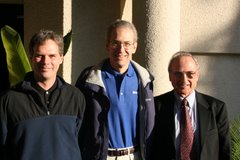Kick back and enjoy a lively and engaging video interview of Charles Vernon Theis who introduced the concept of transient flow to the interpretation of pumping tests. His seminal paper from 1935, "The relation between the lowering of the piezometric surface and the rate and duration of discharge of a well using groundwater storage," is familiar to all hydrogeologists. Learn more about his many accomplishments as well as the groundwater scientists with whom he worked during his long career at the U.S. Geological Survey.
Get more details on the Theis solution at the AQTESOLV website.
Follow AQTESOLV on LinkedIn and Google+ for more updates on aquifer testing!
Thursday, August 28, 2014
Tuesday, May 13, 2014
Classic USGS Pumping Test Video
Check out this classic video of a pumping test conducted by the U.S. Geological Survey in the Little Plover River basin in Wisconsin, USA.
The USGS study made news in a Milwaukee Sentinel article in 1961. A new study in this river basin is underway.
Follow AQTESOLV on LinkedIn and Google+ for more news on aquifer testing!
The USGS study made news in a Milwaukee Sentinel article in 1961. A new study in this river basin is underway.
Follow AQTESOLV on LinkedIn and Google+ for more news on aquifer testing!
Saturday, May 3, 2014
Follow AQTESOLV on LinkedIn!
Are you a member of the LinkedIn professional network?
If so, please visit the new AQTESOLV LinkedIn page and click the Follow button to receive periodic LinkedIn updates pertaining to aquifer testing and AQTESOLV.
While you are visiting LinkedIn, follow the HydroSOLVE company page and feel free to send me an invitation to connect as well!
If so, please visit the new AQTESOLV LinkedIn page and click the Follow button to receive periodic LinkedIn updates pertaining to aquifer testing and AQTESOLV.
While you are visiting LinkedIn, follow the HydroSOLVE company page and feel free to send me an invitation to connect as well!
Tuesday, February 25, 2014
Show/Hide Well Data on Plots
When using AQTESOLV to perform visual curve matching on a data set with multiple observation wells, it's often useful to turn off the display of one or more wells and focus your attention on the remaining wells.
To hide observation data for particular wells, choose Edit>Wells and select the wells in the list that you'd like to hide. Right click over the selection and choose Hide Observations.
To turn on the display of hidden observations wells, select the wells to display, right click over the selection and choose Show Observations.
Find more tips on the AQTESOLV website!
Follow AQTESOLV on LinkedIn and Google+!
To hide observation data for particular wells, choose Edit>Wells and select the wells in the list that you'd like to hide. Right click over the selection and choose Hide Observations.
To turn on the display of hidden observations wells, select the wells to display, right click over the selection and choose Show Observations.
Find more tips on the AQTESOLV website!
Follow AQTESOLV on LinkedIn and Google+!
Wednesday, February 5, 2014
Checking Your Cooper and Jacob Match
Groundwater hydrologists use the Cooper and Jacob (1946) solution to determine the aquifer properties of a nonleaky confined aquifer using drawdowns measured during a constant-rate pumping test. The approximate method of Cooper and Jacob derives from the Theis (1935) type-curve method when the variable u in the Theis well function, w(u), is sufficiently small (i.e., time is large or radius is small).
AQTESOLV has built-in tools to check the validity of analyses performed with the Cooper and Jacob method and to assist you with visual curve matching. First, you can superimpose on your plot the time when u is less than a critical value. Choose View>Options>Plots tab and check the option for Valid time for Cooper-Jacob approximation (Figure 1).
Click the Valid Time tab to set the critical value of u (Figure 2). A critical value between 0.01 and 0.05 is typical.
When you activate the valid time option, a dashed vertical line appears on your time-drawdown or composite plot to indicate the time when the Cooper and Jacob approximation meets the critical value of u (Figure 3). The position of the vertical line is a function of T (transmissivity) and S (storage coefficient) as well as radial distance between the pumping and observation wells..
derivative analysis. After superimposing the derivative on your semilog plot of drawdown versus time, match the Cooper and Jacob straight line to drawdowns corresponding to the derivative plateau, i.e., during the period of infinite-acting radial flow (Figure 4).
Use these two techniques to obtain more reliable results when using the Cooper and Jacob method. Get AQTESOLV and start applying these powerful tools in your next pumping test interpretation!
Visit the AQTESOLV Knowledge Base to find more tips on the using the software. The AQTESOLV documentation also includes a number of examples illustrating the use of the Cooper and Jacob straight-line method.
We invite you to follow HydroSOLVE on LinkedIn and Google+!
AQTESOLV has built-in tools to check the validity of analyses performed with the Cooper and Jacob method and to assist you with visual curve matching. First, you can superimpose on your plot the time when u is less than a critical value. Choose View>Options>Plots tab and check the option for Valid time for Cooper-Jacob approximation (Figure 1).
| Figure 1. Check option to display valid time for Cooper and Jacob solution. |
| Figure 2. Set critical value of u used to check validity of Cooper and Jacob approximation. |
derivative analysis. After superimposing the derivative on your semilog plot of drawdown versus time, match the Cooper and Jacob straight line to drawdowns corresponding to the derivative plateau, i.e., during the period of infinite-acting radial flow (Figure 4).
| Figure 4. Cooper and Jacob method (blue line) matched to drawdown data during period of infinite-acting radial flow when derivative reaches plateau (red line). |
Visit the AQTESOLV Knowledge Base to find more tips on the using the software. The AQTESOLV documentation also includes a number of examples illustrating the use of the Cooper and Jacob straight-line method.
We invite you to follow HydroSOLVE on LinkedIn and Google+!
Thursday, January 16, 2014
IARF and the Cooper and Jacob Method
Groundwater hydrologists routinely use the pumping test interpretation method of Cooper and Jacob (1946), a straight-line approximation of the Theis (1935) type-curve solution, to estimate the hydraulic properties of nonleaky confined aquifers from drawdown data measured during the period of infinite-acting radial flow (IARF) when drawdown changes linearly with the logarithm of time. One expects to find IARF after the dissipation of early-time phenomena (e.g., wellbore storage) and prior to the advent of late-time effects such as aquifer boundaries.
Consider the well-known Theis solution for a constant-rate pumping test in a nonleaky confined aquifer of infinite extent:
where s is drawdown [L], Q is pumping rate [L³/T], T is transmissivity [L²/T], t is time [T], r is radial distance [L] and S is storage coefficient [-].
The Cooper and Jacob method approximates the Theis well function, w(u), by truncating the infinite series in (4) after the first two terms:
The approximation in (5) assumes that u is small, i.e., t is large and r is small. It is precisely when (5) is valid that infinite-acting radial flow is identified from drawdown data.
How small should u be for (5) to be valid? The threshold for IARF (i.e., when Cooper and Jacob becomes valid) is often given as u ≤ 0.05 (Driscoll 1986) or u ≤ 0.01 (Kruseman and de Ridder 1994); however, we can see for ourselves when (5) is valid by plotting w(u) versus 1/u (dimensionless drawdown versus dimensionless time) on semilog axes and looking for a constant logarithmic derivative plateau (Figure 1).
It is evident from Figure 1 that the slope of the drawdown and the value of the derivative are each essentially constant when 1/u ≥ 50. Hence, when u ≤ 0.02, the Cooper and Jacob approximation of the Theis well function is safe to use. Figure 1 demonstrates just how useful derivative analysis can be for the detection of the IARF regime.
Visit Aquifer Testing 101 to learn more about pumping test interpretation with more examples of infinite-acting radial flow.
Follow HydroSOLVE on LinkedIn and Google+!
Consider the well-known Theis solution for a constant-rate pumping test in a nonleaky confined aquifer of infinite extent:
where s is drawdown [L], Q is pumping rate [L³/T], T is transmissivity [L²/T], t is time [T], r is radial distance [L] and S is storage coefficient [-].
The Cooper and Jacob method approximates the Theis well function, w(u), by truncating the infinite series in (4) after the first two terms:
The approximation in (5) assumes that u is small, i.e., t is large and r is small. It is precisely when (5) is valid that infinite-acting radial flow is identified from drawdown data.
How small should u be for (5) to be valid? The threshold for IARF (i.e., when Cooper and Jacob becomes valid) is often given as u ≤ 0.05 (Driscoll 1986) or u ≤ 0.01 (Kruseman and de Ridder 1994); however, we can see for ourselves when (5) is valid by plotting w(u) versus 1/u (dimensionless drawdown versus dimensionless time) on semilog axes and looking for a constant logarithmic derivative plateau (Figure 1).
| Figure 1. Theis (1935) solution (blue curve) plotted as w(u) versus 1/u on semilog axes. Logarithmic derivative shown by red curve. |
Visit Aquifer Testing 101 to learn more about pumping test interpretation with more examples of infinite-acting radial flow.
Follow HydroSOLVE on LinkedIn and Google+!
Thursday, January 9, 2014
Infinite-Acting Radial Flow Regime
A derivative plot is very useful for detecting the infinite-acting radial flow regime under steady pumping conditions. One starts by looking for a derivative plateau (constant derivative) to tentatively identify infinite-acting radial flow. For example, the response data from a constant-rate pumping test shown in Figure 2 suggest that infinite-acting radial flow conditions are present after approximately 30 minutes of pumping once the derivative stabilizes.
| Figure 2. Derivative plot of drawdown (squares) and derivative (crosses) measured in an observation well during constant-rate pumping test in a nonleaky confined aquifer (Walton 1962). |
The foregoing results suggest that the derivative plot is an indispensable tool for aquifer test interpretation; however, the mere existence of a derivative plateau does not immediately confirm infinite-acting radial flow conditions. For example, an aquifer limited by a no-flow boundary can produce a constant derivative that is not diagnostic of the infinite-acting radial flow regime. In such a situation, geologic mapping of lithologic contacts, faults and other low-permeability features would be invaluable in making a correct interpretation.
Visit Aquifer Testing 101 for a catalog of derivative plot signatures with more examples of infinite-acting radial flow in pumping tests.
Follow HydroSOLVE on LinkedIn!
Labels:
derivative analysis,
flow regimes,
pumping tests
Subscribe to:
Posts (Atom)

